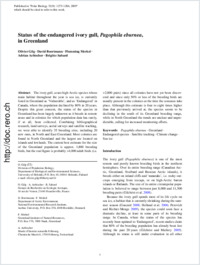Status of the endangered ivory gull, Pagophila eburnea, in Greenland
- Gilg, Olivier Division of Population Biology, Department of Biological and Environmental Sciences, University of Helsinki, Finland - Groupe de Recherche en Ecologie Arctique, Francheville, France
- Boertmann, David Department of Arctic Environment, National Environmental Research Institute, Aarhus University, Roskilde, Denmark
- Merkel, Flemming Department of Arctic Environment, National Environmental Research Institute, Aarhus University, Roskilde, Denmark - Greenland Institute of Natural Resources, Nuuk, Greenland
- Aebischer, Adrian Groupe de Recherche en Ecologie Arctique, Francheville, France - Musée d’histoire naturelle Fribourg, Switzerland
- Sabard, Brigitte Groupe de Recherche en Ecologie Arctique, Francheville, France
-
15.04.2009
Published in:
- Polar Biology. - 2009, vol. 32, no. 9, p. 1275-1286
English
The ivory gull, a rare high-Arctic species whose main habitat throughout the year is sea ice, is currently listed in Greenland as ‘Vulnerable’, and as ‘Endangered’ in Canada, where the population declined by 80% in 20 years. Despite this great concern, the status of the species in Greenland has been largely unknown as it breeds in remote areas and in colonies for which population data has rarely, if at all, been collected. Combining bibliographical research, land surveys, aerial surveys and satellite tracking, we were able to identify 35 breeding sites, including 20 new ones, in North and East Greenland. Most colonies are found in North Greenland and the largest are located on islands and lowlands. The current best estimate for the size of the Greenland population is approx. 1,800 breeding birds, but the real figure is probably >4,000 adult birds (i.e. >2,000 pairs) since all colonies have not yet been discovered and since only 50% or less of the breeding birds are usually present in the colonies at the time the censuses take place. Although this estimate is four to eight times higher than that previously arrived at, the species seems to be declining in the south of its Greenland breeding range, while in North Greenland the trends are unclear and unpredictable, calling for increased monitoring efforts.
- Faculty
- Faculté des sciences et de médecine
- Language
-
- English
- Classification
- Zoology
- License
- License undefined
- Identifiers
-
- RERO DOC 12932
- DOI 10.1007/s00300-009-0623-4
- Persistent URL
- https://folia.unifr.ch/unifr/documents/301216
Statistics
Document views: 108
File downloads:
- aebisher_sei.pdf: 364
